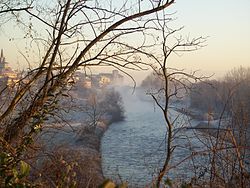Cassano d'Adda
| Cassano d'Adda | ||
|---|---|---|
| Comune | ||
| Città di Cassano d'Adda | ||
 |
||
|
||
| Location of Cassano d'Adda in Italy | ||
| Coordinates: 45°32′N 09°31′E / 45.533°N 9.517°ECoordinates: 45°32′N 09°31′E / 45.533°N 9.517°E | ||
| Country | Italy | |
| Region | Lombardy | |
| Province / Metropolitan city | Milan (MI) | |
| Frazioni | Groppello d'Adda, Cascine San Pietro | |
| Government | ||
| • Mayor | Roberto Maviglia | |
| Area | ||
| • Total | 18 km2 (7 sq mi) | |
| Elevation | 133 m (436 ft) | |
| Population (28 February 2014) | ||
| • Total | 18,756 | |
| • Density | 1,000/km2 (2,700/sq mi) | |
| Demonym(s) | Cassanesi | |
| Time zone | CET (UTC+1) | |
| • Summer (DST) | CEST (UTC+2) | |
| Postal code | 20062 | |
| Dialing code | 0363 | |
| Website | Official website | |
Cassano d'Adda is a town and comune in the Metropolitan City of Milan, Lombardy, Italy, located on the right side of the Adda River. It is on the border of the Metropolitan City of Milan and the province of Bergamo. It is served by Cassano d'Adda railway station.
The first documentary record of the existence of Cassano is the Carlomanno charter from 887 AD.
Due to its strategic position at a crossing of the Adda river a number of historic took place in Cassano:
Other historical people who stopped in Cassano include Napoleon Bonaparte in 1796 and 1807, and King Victor Emmanuel II and Emperor Napoleon III in 1859, just before the Battle of Solferino.
Two artificial canals (the Muzza Canal on the south-east border and the Naviglio Martesana on the northern border) connect the Adda River with Lodi and Milano respectively, making Cassano an important agricultural town and then (thanks to hydroelectric power) an industrial one during the 19th century. The Linificio is a monument to this industrial past, with its 'worker village', very similar as a concept to Crespi d'Adda.
The most important landmark in Cassano is the Borromeo Castle, built around 1000 AD and progressively expanded. In the 15th century, Francesco I Sforza asked architect Bartolomeo Gadio (who also worked on the Milan Cathedral, the Sforza Castle and the Soncino castle) to redesign it extensively. Afterwards, it became the possession of Venetians, Spanish, Austrians, and of the Italian noble families d'Adda, Castaldo, Bonelli and Borromeo.
...
Wikipedia


